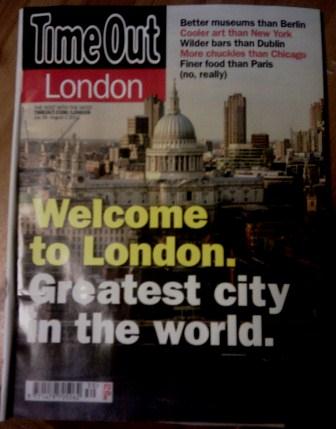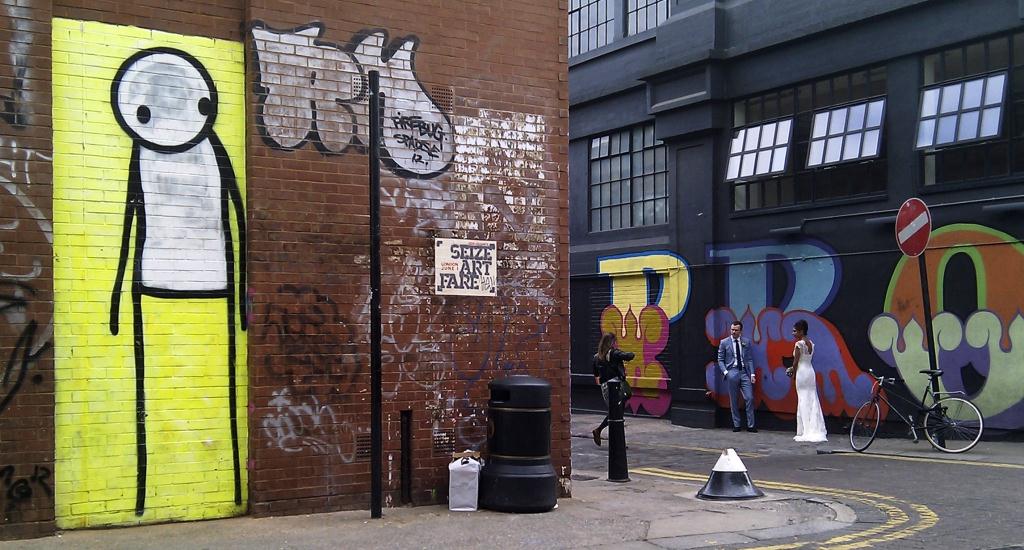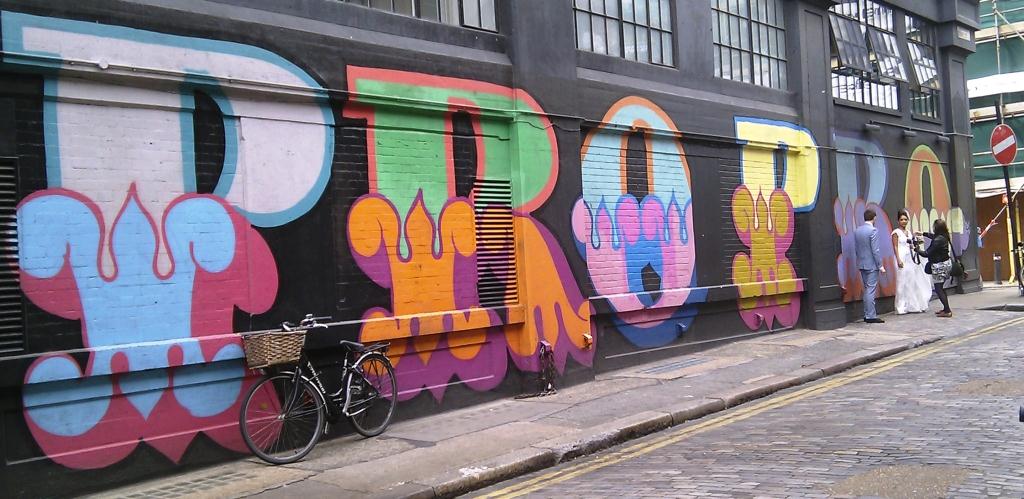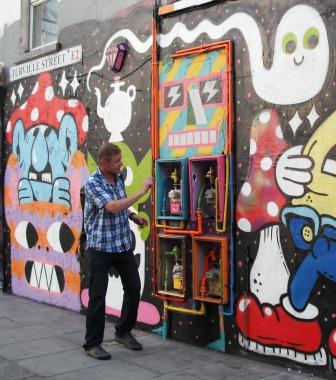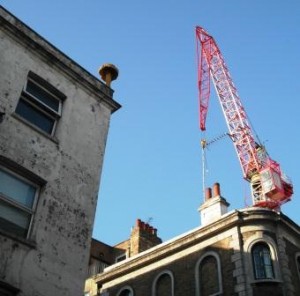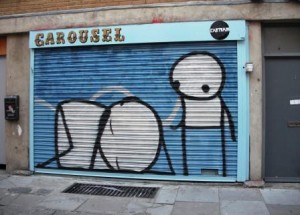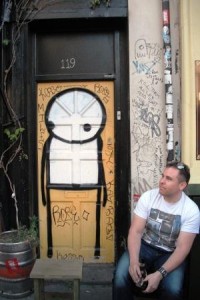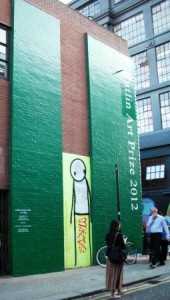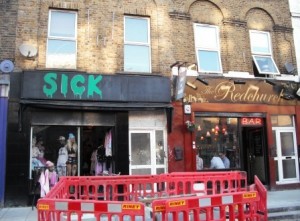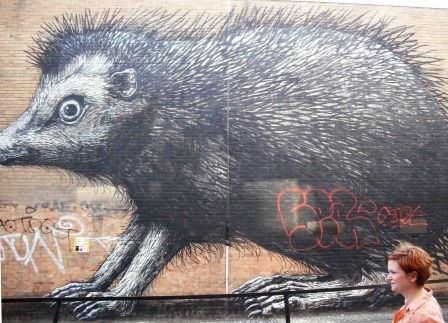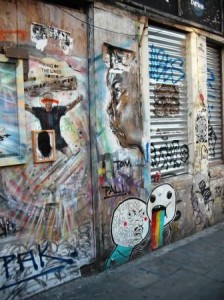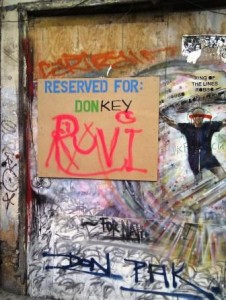…as Boris Johnson inimitably said last night in Hyde Park — before his brilliant put-down of Mitt Romney. Well, my Olympomania Geiger counter has been building up to Zoink steadily over the last few weeks but Boris’s ‘Are we ready?’ speech seems to now catch what seems like a suddenly enthusiastic zeitgeist.
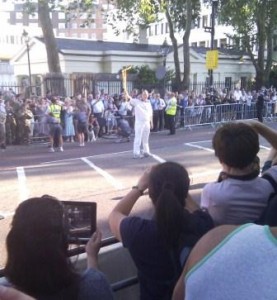
Last night the Olympic Torch came within a hundred yards of where I work for the ‘day job’. It was due to arrive about 6.20pm and there was no way I was going to miss it. Expecting big crowds, quite a few people buggered off out of the office early. In that respect there seems to be two types of people. Those that prefer to preserve their routine from disruption as much as possible and those who are intrigued by the novelty and the new experience. I’d suggest that writers, and creative people generally, would hopefully fall into the second group.
I waited on Birdcage Walk (on what a policeman disconcertingly described to me as a grassy knoll). I saw from distance the bizarre spectacle of the Secretary General of the United Nations handing over the Olympic Torch (I knew it was Ban Ki Moon as I was watching the live TV pictures on my iPad coming from a helicopter overhead ).
In a slight touch of serendipity the torchbearer in my photo is (I believe from the BBC
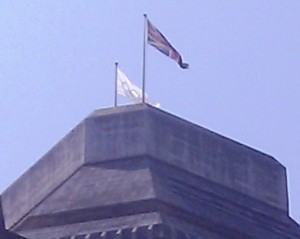
commentary) Jon Sayer, a Scout leader who rescued someone from a swollen river, who comes from Todmorden, a  West Yorkshire town near where I was brought up that has a passing reference in my novel.
I avoided the tube and walked direct to Marylebone Station, passing by Buckingham Palace and having to detour round the torch’s route into Hyde Park — and the atmosphere was fantastic. People were standing on bollards and hanging off lampposts to get a view. A group of Brazilians were parading with their flag around Wellington Arch. Although London in the summer is normally teeming with foreign tourists, there seemed to be a huge number of overseas visitors flocking towards the parks and there were many international TV anchors in position in front of Buckingham Palace.
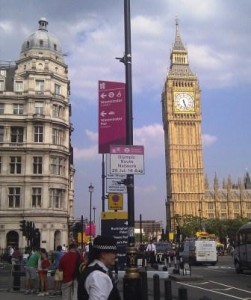
Perhaps because I’ve been working in Westminster in the  writing-time-sapping ‘day job’ for most of the last year, I’ve become fascinated by the way the Olympic preparations have gradually come together — accelerating over the last month and especially over the last week or so.
It’s not so much the big symbols like the rings on Tower Bridge but the small, mundane but essential and attentive details that  have almost had me welling up. For example the lurid bright pink venue signs in the tube stations or the direction signs back to tube stations that have been sprouting on street corners and all over the parks.
(Is that because I try to cultivate a writers’ habit of close observation or that I’m a sign-nerd who did A-level Geography and interested in aspects of place and setting (see my interest in geosemiotics).
It’s also slightly touching to see the Olympic ‘pods’ with their ambassadors in Olympic T-
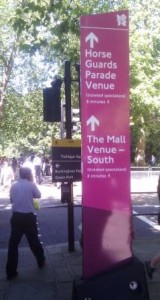
shirts who’ve been put in the parks and on the streets to point visitors in the right direction — although Blue Badge guides they appear not to be.  And the incredible politeness of the soldiers drafted in for security seems fundamentally British. I chatted to some in St. James’s Park on Thursday. These people were probably in Afghanistan a few weeks ago — now they’re pointing tourists in the right direction for Big Ben.
Even though it’s been coming for seven years, when I see the signs to ‘Olympic Park’ I almost have to pinch myself, having memories of watching past Olympics from what have seemed mostly exotic and/or obscure places. I remember visiting Barcelona after their games and constantly being reminded of the Olympics and once I had a tour of the Munich Olympic stadium and a meal in the aerial revolving restaurant there that still had resonance thirty years after the event.
Of course, the Olympics also fascinate as a sporting as well as cultural and symbolic festival. I was on holiday in Scotland during the Beijing games and, having had a tent wrecked by the Scottish weather, spent much of the rest of the time watching Olympic coverage, which became compulsive after a while.
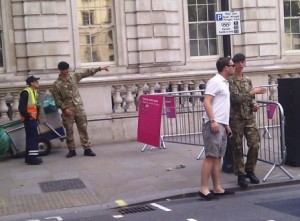
It’s a shame that access to the Olympic Park itself has been so restricted. I’ve had a few glimpses of the stadium and facilities from Hackney Wick and Stratford but I’m sure that people might feel a greater sense of affinity with the Olympic Park itself had it not been cordoned off with extraordinary secrecy. But maybe that’s the point — impress us with the shock of the new?
But perhaps impatiently wanting to go and visit the area shows how the locality has been transformed – would anyone have been so excited about visiting Hackney, Tower Hamlets, Newham or Waltham Forest seven years ago?
There have been plenty of British cock-ups to justifiably complain about — ticketing was a
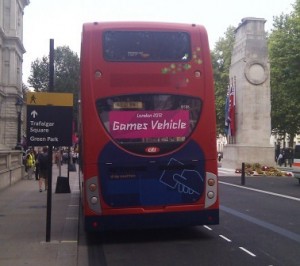
hopeless fiasco. I spent years working on booking systems for airlines and it was inept to use a concert system like Ticketmaster for such a volume of traffic. And I can’t understand why I got no tickets at all on my first attempt when I’d applied for some football tickets — that haven’t even been sold now.
Bizarrely, I ended up with tickets for one of the most sought after events — not the athletics that I also applied for — but the infamous beach volleyball. (My excuse is that I was working through the list of sports alphabetically, not realising I could only apply for three the second time round. And the sessions are for both men’s and women’s volleyball, which no one mentions, of course.) I go on Sunday and I’m also hoping to see the start of the women’s cycling road race as it heads through Hyde Park Corner and Knightsbridge and then go to the London Live Event in Hyde Park.
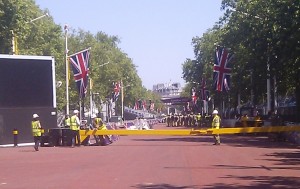
The corporatism increasingly jars with the growing feeling of excitement, which is all the more genuine for arriving seemingly spontaneously. Why can we only pay with Visa? McDonald’s and Coke are the ‘preferred’ food and drink. The brand infringement rules are draconian. But most of these restrictions come via the IOC and we’ve had to accept them, although we police them in our assiduously British way.
And the mascots are ludicrous, although I feel their names have some uncanny personal associations for me (see post from over two years ago). But that’s also a key national characteristic — the resigned humour that comes from the absurd and ridiculous.
London 2012 has already had one real-life moment of stunning absurdity worthy of the

brilliant Twenty Twelve satire before it has officially started — when the South Korean flag was displayed against the North Korean women’s football team (and Twenty Twelve had just sent up women’s football). I can imagine the Hugh Bonneville character’s shambling attempts to defuse that row.
It’s predicted that a billion people will apparently watch the Opening Ceremony, which I’m looking forward to for the music as much as anything else — rumoured to include Muse, the Clash, Queen, the Prodigy, Mark Ronson and Amy Winehouse, the Specials, the Doctor Who theme, bizarrely, ‘God Save the Queen’ by the Sex Pistols. It’s appropriate that the ceremony will also featuring the world’s greatest living songwriter, Paul McCartney, who contributed so much to London’s profile in the 60s.
I’m looking forward to see how the opening ceremony contrasts the Britain of Blake’s green and pleasant lands with the gritty, urban post-industrial Britain of some of the more contemporary artists. My novel also contains many themes derived from the differences and similarities between the two extremes (the London of the City, Shoreditch and Hackney and the rural Chilterns).
I do have a few reservations as there hasn’t been as much hype for a televised public event since, er, the Millennium River of Fire.
As mentioned in previous posts, I’m kicking myself that I’ve not managed to get my novel that, in parts, out into the world by now, as in parts it certainly celebrates London – and some areas close to the Olympic Park. So it’s a slightly selfish hope of mine that the Olympics builds interest so readers want to know more.
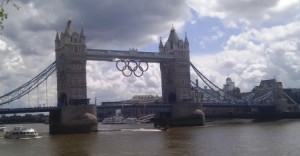
What stirs the profoundest emotion in me is that the Olympics that goes beyond the corporatism and even the sport itself that shows something about the human spirit. The Olympics are a symbol of generosity and hospitality. We’re welcoming everyone else in the world to our city for our games — either in person or via television — to say ‘this is what and who we are and we want to enjoy sharing it’. It’s our London – it’s the city that we’ve all created and we’re going to throw a huge party.
The enormous global prestige of the Olympics is perhaps difficult to appreciate, even a few hours before the opening ceremony. But hearing the news in 2005 that London had been awarded the games was one of those ‘I remember exactly where I was and what I was doing’ moments. I was in a meeting conference room in Greater London House in Camden and someone got the news on their BlackBerry. Everyone in the meeting was stunned because we were so conditioned to losing — London and the UK just didn’t win anything like this. It didn’t happen. But it had — and it was literally unbelievable.
Now it’s here. As the cover of Time Out says (and I agree) it’s the greatest time to be in the greatest city in the world and I feel extraordinarily proud.
